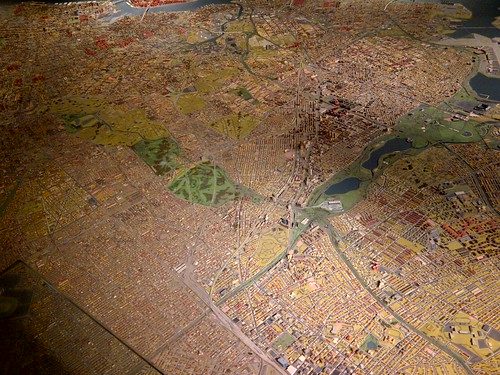There are several exhibits going on right now at the Museum of the City of New York and you should definitely see them.
I haven’t walked around that museum since grade school (I think I did have a sound gig there though) and my favorite then and my favorite still is the Stettheimer Doll House, which is a permanent exhibit.

The Greatest Grid: The Master Plan of Manhattan, 1811-2011 tells the fascinating story of how Manhattan went from a city of unplanned streets and farms to a city with a grid layout that incorporated public spaces. Boss Tweed made money by buying up lots on the soon to be widened Broadway – in most instances the city paid more for a sliver of land than Tammany Hall paid for the entire lot. The farmer who owned the land that became Gramercy Park made sure that the park itself was private – only the people in the buildings facing the park had a key. That practice continues to this day. A lot of people were displaced and shantytowns were demolished (Jacob Riis photographed them before they were gone). The subways followed the north/south avenues.
Upstairs was The Unfinished Grid: Design Speculations for Manhattan. Widening Manhattan so that it reaches New Jersey, Brooklyn, and Queens – that I could see. We certainly generate enough garbage for the landfill. But actually I really can’t see them destroying our natural harbor that way. Most of the plans had Manhattan building up and most of those plans seemed to me to be a way to separate the poor and the rich in a way that side-by-side living doesn’t accomplish.
I was fascinated by Stories the City Tells Itself, which features photographs and videos by Neil Goldberg. There are videos of people emerging from the subway – adjusting to the light and momentarily confused as they get their bearings. People looking at the options at a salad bar. Walking by a lilac bush. Standing on the platform while the wind tunnel from the L train blows their hair around. The disappointment of missing a train. The trapezoid frame of the subway entrance as you look up. The city in the rain. Lifting up store gates. Elderly people getting on a bus. Truck drivers’ elbows.
Cecil Beaton: The New York Years was beautiful. Beaton and Irving Penn posed for each other and Penn later wrote how Beaton had said and done everything exactly opposite of what Penn does and how relaxed Beaton had made him feel. There are beautiful photographs of Marilyn Monroe looking very vulnerable. Beaton was a friend of the Duke and Duchess of Windsor, a lover of Greta Garbo, and a mentor to Truman Capote. As a result he got some of the best photographs of them and the society people he hung out with. He also designed costumes for Broadway, films, and the opera so there are great drawings and photos of Katharine Hepburn, who starred in Coco and Audrey Hepburn from My Fair Lady. There was also a display of the actual costumes from a few operas – from the stitching you could tell that it’s obvious these were not meant to be displayed or seen up close.
Police Work: Photographs by Leonard Freed, 1972-1979 was just that. It wasn’t as bad as I’d feared it would be but it is gritty and very good record of NYC at a certain time.
New York Interiors: Furnishings for the Empire City was six (eight?) dioramas of New York City living spaces from the late 17th century to the early 20th century.
By Carene Lydia Lopez

